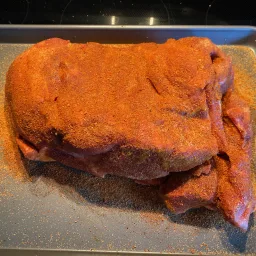
Recipe: Smoking a Pork Butt on a Pellet Grill
Published: June 07, 2022 (Last Modified: July 12, 2024)Who doesn't love the fresh taste of a smoked pork sandwich, or having smoked pork laying around to spice up a sandwich, salad or a burger, or even through it in some eggs for a nice morning smoky scramble.
Making a great smoked pork butt doesn't have to be hard.
We are going to show the perfect recipe to make it, all it requires is a little bit of preparation and some patience.
Ingredients:
| * Yellow Mustard (or some sort of binder) | * Pellet Grill |
| * Seasoning, I prefer something that will add color | * Favorite Pellets (I prefer fruit flavor (Apple, Cherry, Pecan)) |
| * Pork Butt (Bone-in/Boneless) 7-9 pounds | * Aluminum Foil or Butchers Paper. |
1. Selecting a Pork Butt
The first question you need to answer is Bone in or Boneless.
I personally prefer bone in, I think that it adds flavor, and I like the satisfaction of pulling out a clean bone at the end of the cook, it is a good indicator on how well you did. But it is sometimes more difficult to find a bone in pork butt, for example my Costco only has boneless, and my local supermarket sometimes has bone in, but not always.
The best suggestion is if you have a butcher that you like, get it there and support local businesses.
As far as picking which one is best, I try and find one which has a good amount of marbling in the meat, and not a ton of extra fat. Also keep in mind that it will take about an hour a pound to cook. So a 8 pound Pork Butt will take 8-9 hours to cook. This really varies depending on your smoker, the weather outside and the types of pellets you are using.
2. Prepping the Butt
This is really where the magic happens. You want to make sure that you have everything ready and prepared before you open the packaging. Once you have taken the pork butt out and put it on a cookie sheet, I usually pat it dry to get rid of any moisture.
When it is dry I start to look for areas to trim, if there is fat or meat that is hanging off the edge, I usually trim those because they won't cook evenly.
Next, I flip the butt over so that fat side is up, I put some mustard on the butt as a binder, you can choose a gourmet mustard or plain old yellow mustard on it, and spread it around so it is covered, including the sides. At this point I have my mustard binder over the bottom and sides.



I add liberal amounts of seasoning, I want the pork butt to be covered because this is a big piece of meat that can take the seasoning, we are going to cook low and slow. I do this to the bottom and the sides. Next I flip it over so the fat side is down, and do the same thing, add the mustard, and put a thorough covering of seasoning on the top. I go heavier on this side, because we are going to be cooking fat side down, so as the butt is cooking all of that seasoning will make a great bark for the butt. Done with this step!! We let it rest so that must and the seasoning can start working together and penetrate the meat.
Seasonings I like:
3. Starting the Pellet Grill
First put your favorite pellets for pork in your pellet grill. I usually prefer one of the following, Cherry, Apple or Pecan, or a mix of all three.
If you need help deciding we have a handy article to help out - Best Wood For Smoking Pork.
We are going to be cooking this butt at 225 - 235 degrees, we are going to hold this temp throughout the whole cook process. Get your pellet grill going, and let it get up to temp.
4. Smoking the Pork Butt
Once the smoker is up to temp, take your pork butt out and put it on the grill. Simple!
At this point you can decide if you want to put a instant read thermometer in now, or later. I go both ways on this sometimes I put it in now, sometimes later. It really all depends how much attention I want to pay to the cook process. So for this cook I am going to put the thermometer in later. We are going to cook it for around 3 hours, so that it can build up some bark.
At this point we aren't really worrying about the temperature, it is more about getting some smoke on the meat.
5. Checking the Pork Butt
It has been cooking for around 3 hours, and it is now time to add in the thermometer if you didn't add one in the last step. I prefer a thermometer that is either connected to the grill, or is connected to Wifi or Bluetooth, it makes monitoring it so much easier.
Placing the thermometer isn't tricky, pick side, and try and get the front part of the thermometer deep into some meat, but don't touch bone if you have a bone-in butt.
The internal temp is probably in the 120-130s (no big deal if it isn't, every smoker is different). Because we are going to keep smoking it like this until the internal temp is 160 degrees.
6. Wrapping the Pork Butt
At this point the internal temp is 160 degrees or a little higher (this might take 4-5 hours to get here depending on your smoker and the size of the pork butt).
It is time to wrap it!! I generally use two sheets of heavy duty aluminum foil crisscrossed, with the shiny side facing in. I put the Pork butt right in the middle, wrap one set of aluminum foil over it and then the other set.
Next you put the pork butt back onto the smoker, and un-wrap a small part of it where the thermometer goes in, I try and put it into the same place.
Close up the smoker and it is going to smoke until the internal temp is 195 degrees, this is going to take some time.
Towards the end of the cook cycle it seems like getting those last few degrees is taking forever so you might want to goose the temp to 250 degrees to just finish it off.
7. Take it off the Smoker
The internal temp 195 degrees and it is time to take it off the smoker, and let it rest.
A good resting time is between 15 and 20 minutes. We are doing this so that the meat has a chance to re-absorb some of the juices.
